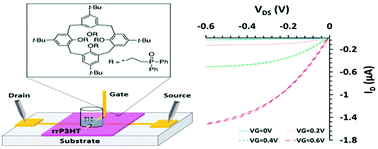A membrane-free cation selective water-gated transistor
Abstract
Sensors for the detection of waterborne cations are of great practical interest, and chemistry has synthesised a formidable catalogue of cation selective complexation agents (‘ionophores’) as selective sensitisers. Current ionophore-based sensors separate the complexation of the cation by the ionophore, and the transduction of complexation into an electrical signal, into separate components. We here unite both functions into a single, sensitised semiconducting layer of a water-gated organic thin film transistor (OTFT). The resulting OTFT transduces waterborne cations into an electrical signal with same selectivity, sensitivity, and limit of detection as established sensors at much simplified preparation and operation. This opens a new route to apply the ‘ionophore’ family of functional organic materials in practical cation sensors.


 Please wait while we load your content...
Please wait while we load your content...